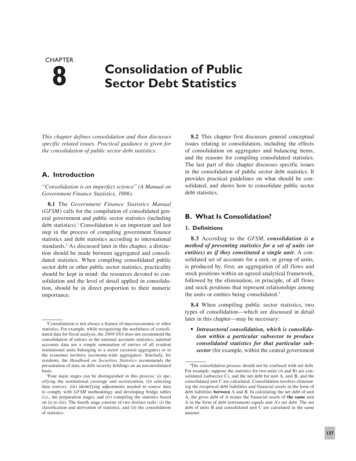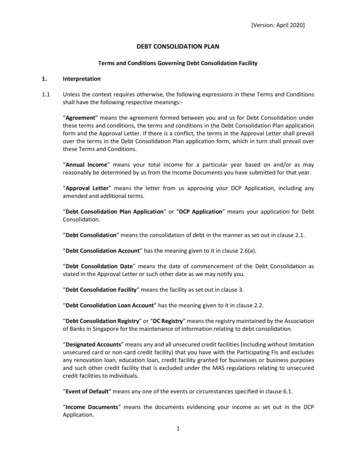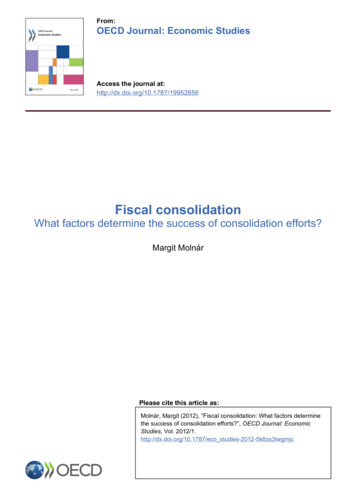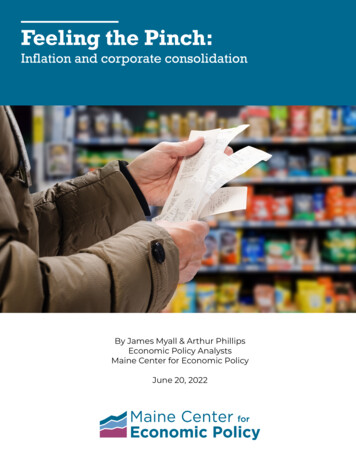
Transcription
CHAPTER8Consolidation of PublicSector Debt StatisticsThis chapter defines consolidation and then discussesspecific related issues. Practical guidance is given forthe consolidation of public sector debt statistics.A. Introduction“Consolidation is an imperfect science” (A Manual onGovernment Finance Statistics, 1986).8.1 The Government Finance Statistics Manual(GFSM) calls for the compilation of consolidated general government and public sector statistics (in cludingdebt statistics).1 Consolidation is an important and laststep in the process of compiling government financestatistics and debt statistics according to inter nationalstandards.2 As discussed later in this chapter, a distinction should be made between aggregated and consolidated statistics. When compiling consolidated publicsector debt or other public sector statistics, practicalityshould be kept in mind: the resources devoted to consolidation and the level of detail applied in consolidation, should be in direct proportion to their numericimportance.1Consolidation is not always a feature of macroeconomic or otherstatistics. For example, while recognizing the usefulness of consolidated data for fiscal analysis, the 2008 SNA does not recommend theconsolidation of entries in the national accounts statistics; nationalaccounts data are a simple summation of entries of all residentinstitutional units belonging to a sector (sectoral aggregates) or tothe economic territory (economy-wide aggregates). Similarly, forresidents, the Handbook on Securities Statistics recommends thepresentation of data on debt security holdings on an unconsolidatedbasis.2Four main stages can be distinguished in this process: (i) spe cifying the institutional coverage and sectorization, (ii) selectingdata sources, (iii) identifying adjustments needed to source datato comply with GFSM methodology and developing bridge tables(i.e., the preparation stage), and (iv) compiling the statis tics basedon (i) to (iii). The fourth stage consists of two distinct tasks: (i) theclassification and derivation of statistics, and (ii) the consolidationof statistics.8.2 This chapter first discusses general conceptualissues relating to consolidation, including the effectsof consolidation on aggregates and balancing items,and the reasons for compiling consolidated statistics.The last part of this chapter discusses specific issuesin the consolidation of public sector debt statistics. Itprovides practical guidelines on what should be con solidated, and shows how to consolidate public sectordebt statistics.B. What Is Consolidation?1. Definitions8.3 According to the GFSM, consolidation is amethod of presenting statistics for a set of units (orentities) as if they constituted a single unit. A consolidated set of accounts for a unit, or group of units,is produced by, first, an aggregation of all flows andstock positions within an agreed analytical frame work,followed by the elimination, in principle, of all flowsand stock positions that represent relationships amongthe units or entities being consolidated.38.4 When compiling public sector statistics, twotypes of consolidation—which are discussed in detaillater in this chapter—may be necessary: Intrasectoral consolidation, which is consolida tion within a particular subsector to producecon solidated statistics for that particular sub sector (for example, within the central government3The consolidation process should not be confused with net debt.For example, suppose the statistics for two units (A and B) are consolidated (subsector C), and the net debt for unit A, unit B, and theconsolidated unit C are calculated. Consolida tion involves eliminating the reciprocal debt liabilities and financial assets in the form ofdebt liabilities between A and B. In calculating the net debt of unitA, the gross debt of A minus the financial assets of the same unitA in the form of debt instruments equals unit A’s net debt. The netdebt of units B and consolidated unit C are calculated in the samemanner.137
PUBLIC SECTOR DEBT STATISTICS: GUIDE FOR COMPILERS AND USERSsub sector or within public nonfinancial corporations subsector); and Intersectoral consolidation, which is consolida tion between subsectors of the public sector toproduce consolidated statistics for a particulargrouping of public sector units (for example,be tween central, state, and local governments, orbe tween general government and public nonfinancial corporations).2. Aggregated vs. consolidated statistics8.5 It is important to distinguish between aggre gatedstatistics and consolidated statistics. When debt statistics(or other statistics) for separate public sector units/entities are added and reciprocal stock positions (or flows)exist but are not eliminated, these statistics are calledaggregated statistics, not consolidated sta tistics (forexample, aggregated general government debt statisticsor aggregated nonfinancial public sector debt statistics).8.6 Technically, the process of consolidation fol lowsthe horizontal aggregation4 of statistics, and it is onlyafter the consolidation process that consolidated statistics are produced (for example, consolidated generalgovernment debt statistics or consolidated nonfinancialpublic sector debt statistics). The labels “aggregatedstatistics” and “consolidated statistics” mean the sameonly if there are no reciprocal stock positions (or flows)among the units for which the statistics are compiled.For public sector statistics, this would be extremelyunlikely.C. What Are the Effects ofConsolidation?8.7 By eliminating all reciprocal stock positionsand flows among the units being consolidated, con solidation has the effect of only measuring flows or4Horizontal aggregation is the process of adding together data forinstitutional units/entities, subsectors, or sectors within an analyticalframework. For example, in GFSM, the debt statistics of the budgetary central government, extrabudgetary central government, andsocial security funds are added (hori zontally) to produce aggregatesfor the “unconsolidated central govern ment.” On the other hand,vertical aggregation of data refers to aggregation of flows or stockswithin the accounts for an in dividual institutional unit, subsector,or sector, and produces “aggregates” that have a specific meaningwithin an analytic framework. For example, in GFSM, debt instruments for a specific institutional unit are added together (vertically)to produce the aggregate “gross debt” for that institutional unit.Balancing items (for example, the net operating balance, net worth,or net debt) are calculated as the difference between aggregates.138stocks of the consolidated unit(s) vis-à-vis units out sidethe boundary. Consolidation will not reflect the economic interaction within the grouping of institu tionalunits, but only those flows or stocks that involve interactions with all other institutional units in the economy(or rest of the world).8.8 Consolidation avoids double-counting of transactions or stock positions among a grouping of institutional units, thus producing statistics that ex clude theseinternal transactions or stock positions. It is this avoidance of double-counting that produces the increasedanalytical usefulness of consolidated statis tics in caseswhere it makes sense to view the con solidated group asacting if it were a single entity.8.9 As illustrated in Box 8.1, in principle, consoli dation does not affect the GFSM balancing items (forexample, the net operating balance, net lending ( ) / netbor rowing (–), net worth, or net debt). In other words,the balancing items produced by simple aggregation(ag gregated statistics) are the same as those produced byconsolidated statistics. This is the result of the sym metryof the consolidation process, wherein the two sides ofthe consolidation adjustment always fall within the samebroad section of the GFSM analytical framework.58.10 When consolidated data produce differentbalancing items from the unconsolidated (aggregated)data, this suggests that errors have been made; con solidation adjustments must be symmetrical, both inprinciple and in practice.65A principal, underlying accounting rule in macroeconomic statistical systems is that transactions take place simultaneously for bothtransactors, and the transaction should be identically valued by bothtransactors. These rules imply quadruple-entry accounting, that is,each unit will have a debit and credit entry, and these entries shouldall be of the same value. In addition, both parties should classify thetransaction (or stock) in the same way. Variations from these standards give rise to many of the practical problems in consolidation ofboth transactions and balance sheet positions. Differences in timingand valuation, as well as accounting discrepancies, may cause asymmetry be tween consolidation amounts. Normally, the more reliablenum ber is used for both sides of the transaction or stock position.Discrepancies from asymmetric recording should always be analyzed and resolved to improve consolidation and the overall qualityof the data compilation process.6In A Manual on Government Finance Statistics, 1986, there wasone major instance in which this symmetry was not observed. Loansfor policy purposes by central government to local government(s)were classified “above-the-line” for central government as lendingminus repayments (a deficit/surplus determining item), while thelocal government clas sified them “below-the-line” as financing. Assuch, consolidating the cen tral government and local government inA Manual on Govern ment Finance Statistics, 1986, resulted in overall deficit/surplus and financing data that were different from whenthe trans actions were simply aggregated. This asymmetry has beenremoved in the GFSM framework by classifying all transactions infinancial assets and liabilities within the same account.
Chapter 8 Consolidation of Public Sector Debt StatisticsBox 8.1. Numerical Example to Illustrate the Effect of Consolidation on Balancing ItemsThe following example illustrates that consolidation has no effect on the GFSM balancing items, including net debt, thebalancing item for debt statistics. The example shows the Statement of Operations, Balance Sheet, and Debt Statistics forthe general government sector and public corporations. The statistics for these two sectors are aggregated and then consolidated to produce the consolidated public sector. In the example, it is assumed that the only intrasectoral transactionand stock position is a loan of 400 from the general government to a public corporation. While the balancing items of the“aggregated public sector” and “consolidated public sector” are the same, the transactions and stock positions in financialassets and liabilities (and debt) would be smaller under consolidation than under aggregation.Statement of Operations (for the edpublic sectorConsolidationConsolidatedpublic sector[1][2][3] [1] [2][4][5] [3] 1,900Net operating balance–300100–2000–200Net acquisition of nonfinancial assets2503506000600Net lending ( ) / net borrowing Net acquisition of financial assetsof which: Loan to public corporationNet incurrence of 400400-4000of which: Loan from governmentBalance Sheet (as at the end of the period)Net public sectorConsolidationConsolidatedpublic sector[1][2][3] [1] [2][4][5] [3] [4]12,3006,5005,80012,3000Nonfinancial assets10,3005,00015,300015,300Net financial ,9000400400–4000Financial assetsof which: Loan to public corporationLiabilitiesof which: Loan from governmentDebt Statistics (as at the end of the edpublic sectorConsolidationConsolidatedpublic sector[1][2][3] [1] [2][4][5] [3] [4]Net debt4,300–4003,90003,900Financial assets corresponding to of which: Loan to public corporationLiabilities in the form of debt instruments(gross debt)of which: Loan from government139
PUBLIC SECTOR DEBT STATISTICS: GUIDE FOR COMPILERS AND USERSD. Why Consolidate GovernmentFinance and Public Sector DebtStatistics?8.11 Government finance statistics have alwaysbeen presented on a consolidated basis.7 The reasonswhy general government statistics should be consoli dated are discussed in detail in the paper Consoli dationof the General Government Sector.8 In sum mary, thatpaper concludes that the main reason for consolidationlies in the analytical usefulness of the consolidated statistics: Consolidation eliminates the distorting effectson aggregates of differing adminis trative arrangementsacross countries. The main im pact of consolidation onthe statistics is on the magni tude of the aggregates.To relate government aggre gates to the economy as awhole (for example, reve nue, expense, or debt to GDPratios), it is better to eliminate the internal churning offunds and include only those flows and stock positionsthat actually cross the boundaries with other sectors ornonresi dents.8.12 The same arguments apply to why public cor porations and public sector statistics should be con solidated; to correct for the distorting effects on themagnitudes caused by the internal flows of funds andstock positions, and thereby including only those flowsor stock positions that actually cross the boun darieswith other sectors of the economy or non residents.8.13 However, because the main analytical use forconsolidated statistics is in the magnitude of the aggregates that are compiled, it may be prudent to determinethe extent of internal flows and stock posi tions beforecommitting substantial resources to the consolidationexercise. In practice, the general guide line to be followed is that resources should be allo cated to identifying consolidation items in direct pro portion to theirnumeric importance (see also para graph 8.17).E. Consolidation of Public Sector DebtStatistics8.14 This section deals with the consolidation of public sector debt statistics. While the discussion focuseson liabilities that are debt instruments, it must be keptConsolidation is not always a feature of macroeconomic or otherstatistics. See footnote 1 in this chapter.8GFSM 2001 Companion Material, Consolidation of the Gene ralGovernment Sector, by Kevin O’Connor (IMF Expert), Ethan Weisman and Tobias Wickens, November 2004, IMF, Washington, /comp.htm)7140in mind that each of these debt liabilities are financialassets (claims) in the accounts of the coun terparty tothe instrument (the creditor). This informa tion is particularly relevant for the consolidation process.8.15 The following liabilities are debt instruments(see Chapter 2, paragraph 2.3): Special drawing rights (SDRs); Currency and deposits; Debt securities; Loans; Insurance, pension, and standardized guaranteeschemes; and Other accounts payable.8.16 After outlining what should be consolidated,some guidelines and rules of thumb are given for application in practice.1. What should be consolidated?a. Conceptual guidelines8.17 Conceptually, the consolidation of debt statis tics entails the elimination of all flows and all debtorcreditor relationships among the units or entities thatare combined. Proper consolidation requires a reviewof the accounts to be consolidated to identify internalstock positions (and flows). The goal is not necessarily perfect consolidation, but rather to eliminate, ina con sistent manner, stock positions (and flows) thatwill have a significant effect on the final aggregates.Where a review of the accounts reveals small stockpositions or flows that may be difficult to identify,resources should not be devoted to identifying thesestock positions, or flows, and their magnitudes.8.18 Two types of consolidation may be neededwhen compiling consolidated public sector debt statis tics: intrasectoral and intersectoral consolidation.In trasectoral consolidation is always done before inter sectoral consolidation. Based on the typical compo nents and sectorization of the public sector,9 Table 8.1indicates for which of these public sector units intraand intersectoral consolidation may be needed.8.19 In principle, SDRs are the only debt instru ment that does not involve any consolidation whencompiling public sector debt statistics. This is because9See Chapter 2 for details.
Chapter 8Table 8.1. Intra- and IntersectoralConsolidation of Public SectorDebt StatisticsPublic sector unitsIntrasectoralconsolidationGeneral governmentsectorIntersectoralconsolidationXCentral governmentX Budgetary centralgovernmentX ExtrabudgetarycentralgovernmentX Social securityfundsXState governmentXLocal governmentXPublic corporations: Public nonfinancialcorporationsXNonfinancial publicsector Public financialcorporationsXXPublic sectorXthe counterparty (creditor) to the SDR debt liability isthe rest of the world (collectively, participants in theIMF’s SDR Department).8.20 For both types of consolidation, the followingmajor transactions, other economic flows, and stockpositions, in likely order of importance, should be eliminated for debt statistics covering any part of, or theentire public sector: Loans; Debt securities; and Other accounts payable.8.21 In addition to the above debt instruments, fordebt statistics that include public financial corpora tions,the following major transactions, other econo mic flows,and stock positions, should be eliminat ed—in prin ciple—in both intra- and intersectoral con solidation: Currency and deposits; and Insurance, pension, and standardized guaranteeschemes. Consolidation of Public Sector Debt Statisticsb. Consolidation of sinking funds8.22 The definition and sectorization of sinkingfunds are discussed in Chapter 2, paragraphs 2.73–2.76,of this Guide. Sinking funds should be included in public sector debt statistics to provide a complete pictureof the public sector’s financial position. Stock positionsand flows of sinking funds controlled by public sectorunits should be eliminated in intra- or intersectoralconsolidation, as appropriate, with those of other publicsector units for which statistics are compiled: For sinking funds that are not institutionalunits: The stock positions and flows of the sinkingfund are combined with those of the parent unit.Any stock positions and flows between the sinking fund and the parent unit should be eliminatedin intrasectoral consolidation because such sinking funds are part of the unit that controls them.For example, the stock positions and flows of asinking fund that is not an institutional unit andcontrolled by the budgetary central governmentshould be combined with the stocks and flows ofthe budge tary central government, with the appropriate con solidation of stock positions and flowsbetween them. For sinking funds that are separate institutional units operating on a nonmarket basis(i.e., gov ernment units): Stock positions andflows be tween the sinking fund and the parentunit are eliminated in intersectoral consolidationwhen data are compiled for a group of public sector units that include the sinking fund. These sinking funds would be classified as extrabudgetaryunits of the unit that controls them. For example,when com piling consolidated central governmentGFS or debt statistics, a sinking fund that is controlled by the budgetary central government wouldbe con solidated with the stock positions and flowsof other central government units. For sinking funds that are separate institutional units operating on a market basis (i.e.,public fi nancial corporations: Stock positionsand flows between the sinking fund and the parentunit are eliminated in intersectoral consolidationwhen data are compiled for a group of public sector units that include the sinking fund.8.23 When combining the statistics of the parentunit and a sinking fund, the consolidated total shouldrepresent only the consolidated unit’s stock positionsand flows with the rest of the public sector, economy,141
PUBLIC SECTOR DEBT STATISTICS: GUIDE FOR COMPILERS AND USERSor world. In doing so, the following stock positions andflows are eliminated: Transactions and other economic flows betweenthe parent unit and the sinking fund, including theparent unit’s contributions to the sinking fund forthe redemption of debt; and Stock positions between the parent unit and thesinking fund, including holdings of “parent” gov ernment debt.8.24 Sinking fund payments to units outside thegroup of units included in the statistics (for example,to the private sector or to nonresidents) are shown as: The redemption of debt liabilities of the parentunit because these liabilities are recorded on thebalan ce sheet of the parent unit (it is for this reasonthat it is important to include sinking funds in thesta tistics); or The acquisition of financial assets for the sinkingfund if the sinking fund is a separate institutionalunit. If the sinking fund is not a separate unit, theacquisition of financial assets by the sinking fundis recorded on the balance sheet of the parent unit.8.25 When calculating gross debt of the sinkingfund, and the sinking fund is a separate institutionalunit, its holdings of financial assets should not beoff set against its own liabilities. However, financialassets of sinking funds’ that are institutional units areincluded in the calculation of their own net debt. Thesame calculations apply to the gross and net debt ofthe parent unit. When combining the statistics of thesinking fund that is a separate institutional unit, andthe parent unit, gross and net debt for the combinedunit are calculated after appropriate consolidation ofintra- and/or intersectoral stock positions.2. Practical guidelines8.26 In the preceding sections, the focus waslarge ly on the conceptual issues relating to consolidation and identifying stock positions (and flows) wherecon solidation may be necessary. All stock positions(and flows) to be consolidated should be identified inthe accounting codes for stock positions (and flows) inthe general government accounts, with the counterpartyof the stock position (or flow) clearly identified. Sourcedata on public corporations exist separately from thegovernment accounting codes and charts of accounts.As advocated in Chapter 6, these data on public corpo rations’ activities should be reported regularly to thegovernment finance statistics or public sector statis142tics compilers. Ideally, in the public sector debt statistics compilation system, public sector accounting datashould be linked (bridged) to the GFSM classificationcodes and the items to be eliminated in consolidationshould be clearly identified.a. Priorities in consolidation8.27 Practicality should be kept in mind whenconsolidated public sector debt statistics are compiled,and the decision about the level of detail employed inconsolidation should be based on the: Analytical and/or policy usefulness of the con solidated data; and Relative importance of the various types of stockspositions.8.28 Unless significant and identifiable, this Guidedoes not recommended intra- or intersectoral con solidation of “other accounts payable” (or receivable)when compiling consolidated debt statistics for thepublic sector or any subsector thereof. In practice, itwill most likely not be possible to eliminate intra- andintersectoral stock positions in “other accounts pay able” (or receivable) because of a lack of detail. Also,in practice, it would be difficult—if not impossible—toallocate insurance technical reserves to specific pol icy holders.10 Stock positions between government andpension funds classified as public financial corpo rations are either considered to be between households(government employees) and the pension funds, or willlikely be insignificant. It is also unlikely that there willbe a need for consolidation of standardized guar anteeschemes among public sector units.8.29 Thus, for debt statistics covering any part of, orthe entire, public sector, it is recommended that prioritybe given to identifying the following potential areas ofintra- and intersectoral consolidation of stock positions(and flows)11: loans, debt securities, and currencyand deposits.128.30 Often, discrepancies exist between data for twounits that are being consolidated. In principle, when atransaction or stock position to be consolidated is identified (for example, a loan from the central gov ernmentto a public nonfinancial corporation), it is ex pected that10Insurance technical reserves are liabilities of the public finan cialcorporations and financial assets for the policyholders.11These refer to debt instruments as well as their correspondingfinancial assets in the accounts of the creditor.12Consolidation of currency and deposits is particularly impor tantwhen public financial corporations are included in the sta tistics.
Chapter 8the corresponding records will be found in the accountsof the counterparty (in this case, the public nonfinancial corporation). However, when the public nonfinancialcorporation’s accounts are review ed, there may be norecord of this loan, or the loan may be credited in a different period, or the loan receivable may have a differentvalue from the loan payable, or it may be classified assomething other than a loan. There are many reasons forsuch discrep ancies, some of which are discussed in detailin papers on the consolidation of general governmentand non financial public sector statistics, respectively.13Re solving these discrepancies will promote proper con solidation and improve the overall quality of the data.b. Rules of thumb8.31 Some practical rules of thumb can be helpful to determine: (i) if there are stock positions tobe consolidated; (ii) whether or not to measure thembased on their magnitude and cost of collection; and(iii) which unit may be considered to have the mostreliable records. Circumstances in each country vary,and the rules that are chosen must be based on coun tryspecific circumstances. Suggestions for general rulesof thumb and the sequence for analysis are14: Begin all consolidation exercises with an analysisof the accounts involved to determine if thereare stock positions internal to the unit(s) to beconsoli dated. This will depend on knowledge ofthe re lationships among the units involved. Dosome units extend loans to other units? Do theybuy debt securities issued by others? Do they havecurrency and deposits held by others? Once these relationships are established, compilers must determine whether the intra- and/orintersec toral stock positions can be measured orestimated, and whether the amounts will be significant in terms of analytical importance. If the amounts are likely to be significant, are theylarge enough to justify the effort to collect the dataand other information for consolidation purposes?(The effort and cost to identify an amount to beconsolidated should be directly proportional to theexpected amount and its impact on the aggregates.)13GFSM 2001 Companion Material, Consolidation of the GeneralGovernment Sector, and GFSM 2001 Companion Ma terial, Nonfinancial Public Sector Statistics—Consolidation, by Tobias Wickens, October 2008, IMF, Washington, DC. mp.htm)14Successful consolidation will depend on the accuracy achiev edin the preparation and derivation of the public sector debt statistics. Consolidation of Public Sector Debt Statistics The “one-side” rule of thumb is commonly used.If there is convincing evidence from one of thetrans actors that a stock position exists in the balance sheet, it should be imputed to the other side,even in the absence of the counterpart records.When such an adjustment is made in the data fora unit where the stock positions cannot be directlyidenti fied, it will be necessary to ensure that therecords for that unit are properly modified. For stock positions (and flows) in financial assetsand liabilities (including debt liabilities), normally the creditor can be expected to maintain themost reliable records. For loans, the creditor unitusually maintains the most complete records, but,with the international emphasis on proper debtrecording, the debtor unit may be equally reliable. For debt securities, especially bearer instruments, only the creditor may have the informationneeded for con solidation. For example, when acentral govern ment issues bearer securities, someof which are acquired by public corporations, thecentral gov ernment may have no direct information on who is holding the securities, especially ifthey can be acquired on secondary markets.15 It is,therefore, necessary to rely on the creditor recordsof the public corporations.3. How to consolidate?8.32 In applying the principle of consolidation topublic sector debt statistics, compilers will combine thestatistics for a group of units or entities and then subtract intra- and/or intersectoral stock positions amongthe units being combined. In the IMF’s statis tical database, this subtraction is achieved by entering consolidation amounts as negative numbers. The con solidated setof statistics is produced by summing all the individual15Existing public sector debt instruments acquired on second a rymarkets should not be consolidated in transactions data, if thesetransactions take place with nonpublic sector units. However, theseacquisitions should be consolidated in balance sheet or debt statistics. In cases where public sector units issue negotiable securitiesthat trade in secondary markets, the debtor-creditor relationshipbetween the public sector and the holder of the security may changeduring the life of the security. For example, a central governmentbond may
This chapter defines consolidation and then discusses specific related issues. Practical guidance is given for the consolidation of public sector debt statistics. A. Introduction "Consolidation is an imperfect science" (A Manual on Government Finance Statistics, 1986). 8.1 The Government Finance Statistics Manual










